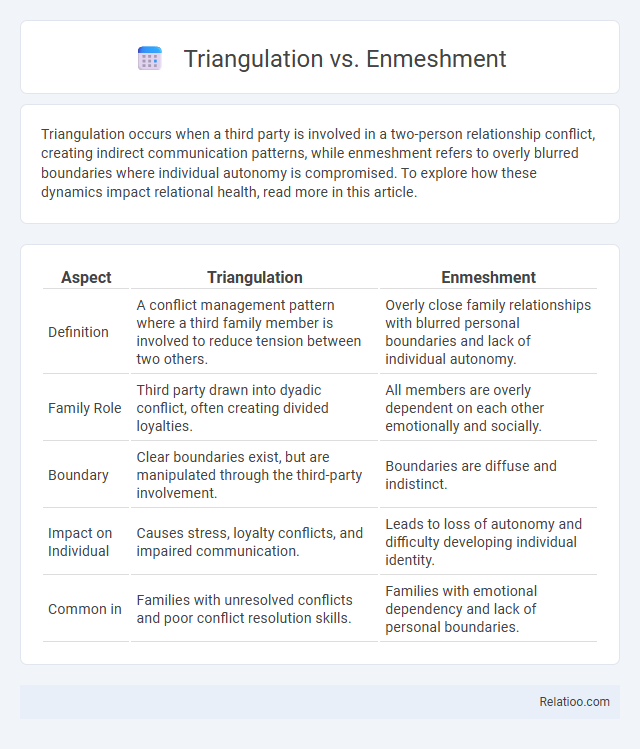Triangulation occurs when a third party is involved in a two-person relationship conflict, creating indirect communication patterns, while enmeshment refers to overly blurred boundaries where individual autonomy is compromised. To explore how these dynamics impact relational health, read more in this article.
Table of Comparison
| Aspect | Triangulation | Enmeshment |
|---|---|---|
| Definition | A conflict management pattern where a third family member is involved to reduce tension between two others. | Overly close family relationships with blurred personal boundaries and lack of individual autonomy. |
| Family Role | Third party drawn into dyadic conflict, often creating divided loyalties. | All members are overly dependent on each other emotionally and socially. |
| Boundary | Clear boundaries exist, but are manipulated through the third-party involvement. | Boundaries are diffuse and indistinct. |
| Impact on Individual | Causes stress, loyalty conflicts, and impaired communication. | Leads to loss of autonomy and difficulty developing individual identity. |
| Common in | Families with unresolved conflicts and poor conflict resolution skills. | Families with emotional dependency and lack of personal boundaries. |
Understanding Triangulation: Definition and Dynamics
Triangulation involves a third party in a two-person conflict to reduce tension or gain leverage, often leading to dysfunctional communication patterns within relationships. Enmeshment refers to overly diffuse boundaries between individuals, resulting in a loss of autonomy and unhealthy emotional interdependence. Understanding triangulation dynamics highlights how involving a third person can exacerbate conflicts, whereas enmeshment blurs individual identities, both undermining healthy relational boundaries.
What is Enmeshment? Key Characteristics
Enmeshment is a dysfunctional family dynamic characterized by blurred boundaries where individual autonomy is compromised due to excessive emotional involvement and dependence. Key characteristics include lack of personal privacy, overly close relationships that hinder independence, and difficulty distinguishing emotions and roles within the family system. This creates challenges in establishing healthy interpersonal boundaries and promotes codependency, often leading to emotional confusion and identity issues.
Triangulation vs Enmeshment: Core Differences
Triangulation involves a third party in conflicts between two individuals, creating a communication triangle that diffuses tension but can perpetuate dysfunction, whereas enmeshment refers to overly blurred boundaries within relationships, leading to a loss of individual autonomy and identity. Triangulation often manifests in family systems therapy as a coping mechanism in high-conflict situations, while enmeshment is characterized by excessive emotional involvement and dependence. Understanding these core differences is crucial for addressing relational dynamics effectively in psychological and therapeutic contexts.
Psychological Impact of Triangulation
Triangulation in psychology often leads to increased anxiety and confusion as individuals feel caught in conflicting loyalties between two parties, impairing healthy communication and emotional expression. Enmeshment, characterized by blurred boundaries and over-involvement, results in dependency and difficulty in establishing personal autonomy. The psychological impact of triangulation specifically exacerbates feelings of manipulation and mistrust, contributing to emotional distress and dysfunctional relationship patterns.
Emotional Consequences of Enmeshment
Enmeshment in family systems creates blurred boundaries, causing individuals to struggle with autonomy and self-identity, often leading to emotional dependence and anxiety. Unlike triangulation, where a third party is drawn into conflict to stabilize relationships, enmeshment fosters intense emotional entanglement that can impair healthy emotional regulation and resilience. The emotional consequences of enmeshment include increased vulnerability to depression, difficulty establishing personal boundaries, and impaired social functioning.
Signs You Are Experiencing Triangulation
Signs you are experiencing triangulation include feeling caught in the middle of conflicts where communication is indirect, and two parties involve you to avoid direct confrontation. You may notice inconsistent information or a sense of divided loyalty between the individuals involved, causing emotional stress and confusion. Recognizing these patterns helps you set boundaries and promote healthier, more direct communication in relationships.
Recognizing Enmeshment in Relationships
Recognizing enmeshment in relationships involves identifying blurred personal boundaries where Your sense of self becomes overly dependent on others, leading to a loss of autonomy and emotional independence. Unlike triangulation, which manipulates interactions by involving a third party to reduce tension, enmeshment creates a fusion of identities, making it difficult to differentiate individual emotions and needs. Awareness of these patterns is crucial for maintaining healthy, balanced connections and establishing clear, respectful boundaries.
Overcoming Triangulation: Effective Strategies
Overcoming triangulation requires setting clear boundaries and fostering direct communication between conflicting parties to reduce reliance on intermediaries. You can implement structured conflict resolution techniques and promote emotional awareness to avoid enmeshment, where personal boundaries become blurred. Consistently encouraging openness and accountability helps break the cycle of triangulation, enabling healthier, more transparent relationships.
Healing from Enmeshment: Steps to Independence
Healing from enmeshment involves setting clear personal boundaries and reclaiming your individual identity separate from family dynamics. Understanding the differences between triangulation, where a third party is drawn into conflicts, and enmeshment, characterized by blurred personal boundaries, helps you navigate unhealthy relationships. Prioritizing self-awareness, therapy, and consistent boundary enforcement are crucial steps toward achieving emotional independence and healthier connections.
Building Healthy Boundaries: Preventing Dysfunction
Building healthy boundaries requires distinguishing triangulation, which involves a third party to reduce tension between two individuals, from enmeshment, characterized by blurred personal boundaries and over-involvement. Recognizing these dynamics helps You avoid dysfunction by maintaining clear interpersonal limits and promoting direct communication. Implementing firm boundaries prevents the emotional entanglement that occurs with enmeshment and mitigates the conflict escalation often triggered by triangulation.

Infographic: Triangulation vs Enmeshment
 relatioo.com
relatioo.com